April Davila's Blog, page 28
December 11, 2019
Please Don’t Send Your NaNoWriMo Manuscript to Agents


Well, it’s officially December, and for a lot of writers out there that means NaNoWriMo is over. Did you do it? Did you hit your goal? If you did (and, hell, even for those who gave it their best shot) I’m so effing proud of you. You did it! You should do something to celebrate: go out for drinks, get a massage, buy yourself a tub of cookie dough ice cream and go to town. The one thing you should not do, under any circumstances, is send your NaNoWriMo manuscript to agents.
Seriously.
I’m kind of surprised this even needs saying, but apparently there is a whole contingent of writers out there who slap out 50,000 words and start querying agents. WTF?
First of all, 50,000 isn’t even long enough to be considered a proper novel. And never mind that, you’re sending a first draft to an agent? I don’t even let my husband read my first drafts. First drafts are supposed to be shitty. And they are. Count on it.
Okay, okay, I’m sure you’re the exception. I’m sure that you are so brilliant that an agent will totally overlook the typos and inconsistencies in your writing. I’m sure they will be so enamored of your pages and pages of dialogue that they won’t be able to sleep and will sit by the phone until it’s 8am and they can reasonably expect you to be awake so that they can call you and beg you to be their client.
I’m also sure you’re insane.
Please, please don’t send your NaNoWriMo manuscript to agents. It’s not only embarrassing for you, it builds a bad reputation for every serious writer who used the NaNoWriMo challenge to kick off (or make progress on) a serious writing project.
Here’s what to do instead:
Keep writing (until you get to about 80,000, depending on what you’re writing – check out this word count guide to see what the standards are in your chosen genre.).Then stick it in a drawer for about three months and do something else, like start another project. Come back and read it through.Edit. A lot.Have some trusted friends read it. Edit some more.Stick it in a drawer for another three months.Read it again.Edit again.Repeat steps 5-9 as necessaryHire a professional editor to do a final pass.
Then, and only then, start sending out your query letter.
Or don’t do all that. There’s no law that dictates what you have to do with your 50,000 words. You could serialize them on your blog, or self publish, or make yourself a suit by stapling the pages together then use the remaining pages to make a paper mache hat to match. It’s your art.
But if you want to go the traditional route of finding an agent and a subsequent publisher, you still have a lot to do.
Writing is work. To pretend it isn’t is insulting to us all.
December 9, 2019
Scrivener Drafts
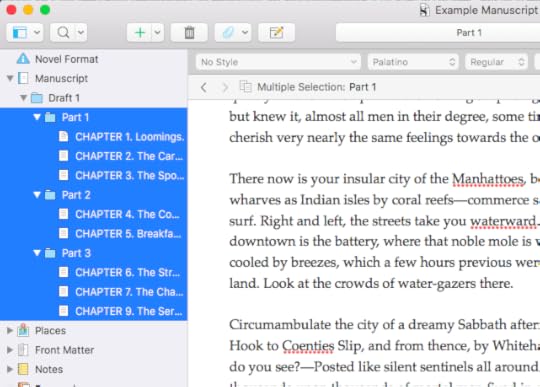
Today we’re continuing the #52WeeksOfScrivener series with a discussion about saving whole drafts of your WIP (work in progress).
Small Changes
In a previous post, I talked about how to track line edits using the Scrivener Snapshot function. In short, it’s an easy way to save a copy of the section you’re working on, before you start messing around with it, so that you can revert back to what you had if things go terribly awry.
This is a handy little trick, but when you’re doing massive overhauls, it can feel a bit piecemeal.
The Challenge of a Second Draft
If you follow along with the blog, you know I’m working on draft two of my second novel, and that I’m embarking on some massive edits. Basically, I’ve been typing away at this baby for years, and now it’s time to transform it from a collection of pages into a real story.
While I don’t want to start editing without saving what I have, it feels a little tedious to do a snapshot of each chapter. Also, I tend to forget to do things like backing up my work once I get rolling creatively.
So I devised a super simple way to keep my first draft, in the same file as the second, so that it stays as it is and I can always come back to it. It’s really pretty simple.
Saving Drafts in Scrivener
Step 1. To start, click on “Manuscript” at the top of your binder. Then click the little dropdown icon next to the plus sign in the top menu bar and select “New Folder”.

Step 2. Name that new folder “Draft 1.”
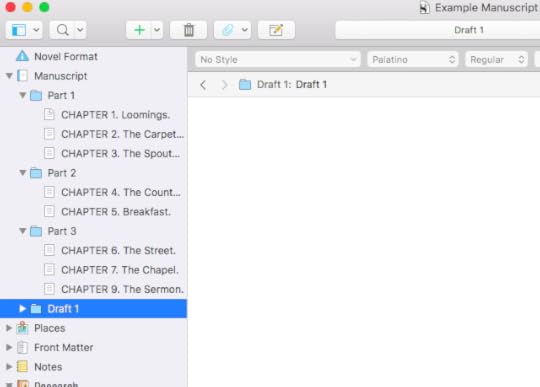
Step 3. Select/highlight the folders of your first draft and move them to the new folder.

Step 4. While they are still selected/highlighted, copy them by going to Documents -> Duplicate -> with Subdocuments and Unique Title.
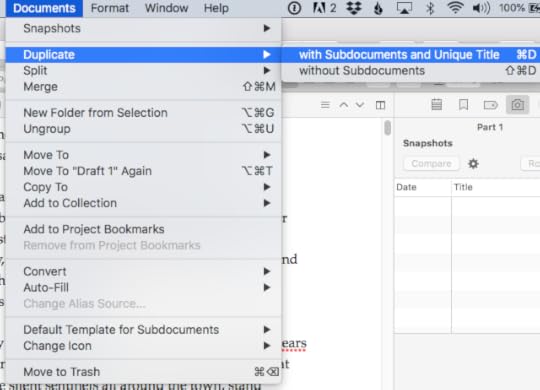
Step 5. Repeat steps 1 and 2, but name the new folder “Draft 2” then move the copies you created in step 4 into that new folder.

Notice how, under “Manuscript” I now have all my folders organized in the Draft 2 folder, but at the bottom, I also have the Draft 1 folder. It will just sit there, out of the way, in case I ever need to go back to it.
I could even move it down into the research folder if I wanted to get it out of the way, which is nice if you pay attention to word counts and don’t want that first draft to beef up your total.
Now I can hack away at my draft without any fear of not being able to find something from an earlier version and without cluttering up my files on my computer.
This, once again, is the brilliance of Scrivener. Everything to do with this project, stays in this one file, no matter how big and sprawling it gets.
Give it a try. Let me know what you think.
Next Week…
Next Monday we’re keeping it light, because the holidays are fully here, and I don’t have time to do much more than play around with binder icons. Stay tuned, follow on Twitter with #52WeeksOfScrivener, or sign up for my newsletter to get a weekly digest of all my posts.
December 6, 2019
Agricultural Islands

 This post is part of an extended series I’m writing about California.
This post is part of an extended series I’m writing about California. You can find out more on my Why California page.
Historically, the waters of the Sacramento and San Joaquin rivers flowed unrestrained down into the Sacramento Delta, ultimately finding their way to the San Francisco Bay. Annual flooding brought fresh layers of sediment to the valley, slowly building up fertile soil underneath the extensive estuary.
To encourage reclamation of the land for farming, California passed the Swamp and Overflow Act in 1861. The following twenty years brought thousands of laborers, most of them Chinese immigrants, who dredged canals, built up levee walls and drained excess water from over 88,000 acres of land to create agricultural islands.
Many of the Chinese laborers settled into the Walnut Grove area to become farm workers, but when large portions of the city’s Chinatown burned down in 1915, some of the residents rented land from George Locke and built the only town in America constructed for Chinese by Chinese.
Locals stop by the unchanging town of Locke to visit Al’s Place (better known as Al the Wop’s), after a long day of waterskiing on the regions 100s of miles of navigable waterways.
The agricultural islands themselves continue to be some of the state’s most fertile lands, growing a wide range of vegetables, grains, and fruits, and contributing billions of dollars to the state’s economy.
December 4, 2019
NaNoWriMo 2019

 What my month looked like in words written.
What my month looked like in words written.I’ll be honest, I kind of hate that the NaNoWriMo challenge is in November. It’s such a busy month. My kids got the WHOLE WEEK off for Thanksgiving, and my husband’s birthday is at the end of the month, and my son’s birthday is in early December so I have to devote at least a little time to making some plans for him. Then, you know, just for fun, our water heater died, the garage door broke and the dogs wouldn’t stop peeing on things.
But whatever. It’s over now and I (somehow) managed to write 50,000 words in 30 days! That’s a lot of words. Of course they’re shitty first-draft words, but still, a lot of words. I’ve read that only 15% of people who start NaNoWriMo actually finish, so, feeling pretty good about that.
This is the third time I’ve done the challenge. The first time was a qualified success. The second got me a great start on my second novel. This year, I’m working on novel number three. (I’m not good with titles, so they get numbers up until the very end.) And I ended up doing a few things differently this year:
Writing By Hand
This year, I wrote most of my words by hand. I have never done this. Ever. But I hate carrying my laptop around and I’m just super busy so I slipped a spiral notebook into my purse and started grabbing any free 15 minutes to do a little writing sprint. I counted up my words per page to get an average (about 300 per), and just used that when I tally things up at the end of the day.
The first thing I’ve noticed is that I can actually get a lot of writing done this way. Waiting for my kid’s soccer practice to end? That’s 600 words. Waiting for teeth to get brushed? Another 600.
The other thing that became quickly apparent was that my inner critic had to sit the eff down. Can’t edit on the paper (aside from the occasional arrow or margin note). But I know I will be able to edit as I type it all in at some point. So that has also helped with quieting that pesky inner critic.
Writing In The World
Writing in my notebook has given me a sudden aversion to writing in my office, at my desk. I’m writing on the couch, at the coffee shop, over a salad for lunch at my local diner.
This is a huge shift for me. I love my office. I’m usually all about my office, but now I’m finding that when I sit at my desk, my computer sucks me in (like, for instance, how I had planned to write when I sat down just now and ended up drafting this blog post instead).
Getting away from my desk helped me limited distractions.
Mornings
I’m not writing in the mornings as much. Used to be that my creative time was from about 5am to 11am and then I was spent. I worked hard to carve out that time because if I didn’t get my writing done then, it didn’t happen.
Truth be told, I’m still not much good after dinner. By the time I get the kids to bed my brain is mush. But my “creative time” seems to have opened way up. I can write in the mornings as easily as I can write at my boy’s taekwando practice at 5pm. I guess I’ve gotten less precious about it. Being in shitty-first-draft mode helps.
Just Keep Writing
I think the most surprising thing I’ve found this year is that the words keep coming. I’m usually a planner. My second novel was a 60 page outline before I wrote a scene. This time, I just dove on in.
Every damn day I think, I don’t know what I’m going to write. But I sit down, and I start and the words come and – what do you know? – a story is taking shape. It’s my first pantsing experience. It’s a little scary, but also kind of exhilarating.
Also daunting is the idea that I’m going to have to type up about 200 pages of written prose (ug), but like I said above, at least that process will allow me to edit and make it better. My first typed draft will actually be a second draft. That’s kind of cool.
But for now, I’m jumping back to novel 2. I’m about 2/3 of the way through a draft that’s good enough that I might let a few people read it. I’m really hoping to wrap it up before my debut novel comes out on February 25th. That gives me twelve weeks, two of which the kids are off school. I think I can get it done… Stay tuned.
December 2, 2019
Explore Your Project History in Scrivener

We’re continuing the #52WeeksOfScrivener series today by talking about your Project History. As you’ve probably figured out by now, I like data, especially data that shows me I’m making progress on my projects.
Find Your Project History
This is such a simple little thing, but I just love it. Start by clicking on Project -> Writing History. Like this:
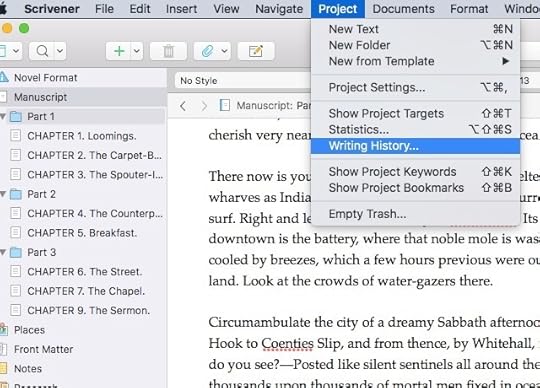
What you’ll get is a pop-up window like this one:
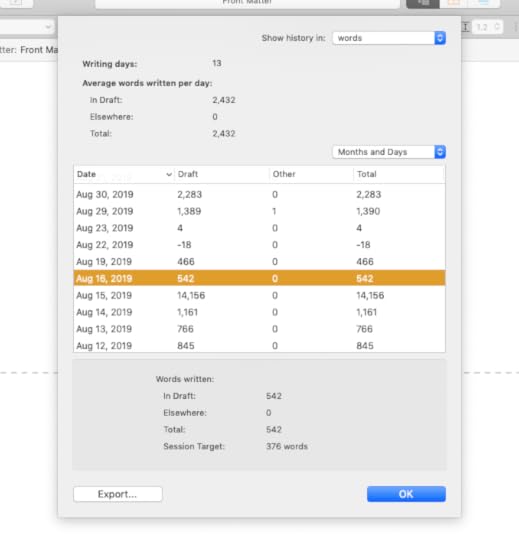
Now, I usually don’t share from my WIP (did you recognize the opening chapter of Moby Dick in the first image?), but since I don’t actually work on that mock-up on a day-to-day basis, I had to pull from my own work to show you the rest. And, no, I didn’t actually write 14,156 words on August 15. I was copying some work from an old Word doc into this new project.
Day by Day
Start at the top with writing days. Since I’ve started this new project, I’ve actively worked on it on 13 different days. Funny. It feels like a lot more. And in truth, this count only goes back to the day I resurrected this project and uploaded it from Word, so I actually have spent a lot more than 13 days on it. But 13 since I got serious. Moving on…
Below that, you can see average words (and note that you can switch to characters by using the drop down menu at the top right there – and if you do, will you please tell me in the comments below why you prefer that? I’ve never understood why that’s a thing).
I also like to look at the dates lined up in the first column there. I try to write six days a week when I’m working on a draft. It would appear I didn’t quite hit that goal, but I was working pretty consistently. Yeah me.
The data at the bottom there is a summary of the highlighted day, August 16 in this case. I like that it also gives you the session target. If you’re not familiar with setting daily word count targets, check out my post on that. It’s SUPER handy when you’re working toward a specific goal. Cough*NaNoWriMo*cough.
Lastly, you can toggle from “Months and Days” to “Months Only” (on the right there above the chart), to get a wider perspective on your work.
Month by Month
Since I don’t have enough data on the new project yet, here’s what my last project looked like:

March was a good month. Kind of made up for January. Stupid January.
Anyway, you can see how the data at the bottom shifts. Under “Words written” the first column displays totals. The column on the right you can change with the drop-down menu.
For this example I chose to show averages, but you can also do maximum in a day or minimum in a day.
So that’s it. Just a quick and easy way to review your writing habits and see the progress you’re making. Happy writing!
Next Week…
Next Monday we will explore the ways we can manage whole drafts in Scrivener. Stay tuned, follow on Twitter with #52WeeksOfScrivener, or sign up for my newsletter to get a weekly digest of all my posts.
November 29, 2019
Sourdough

 This post is part of an extended series I’m writing about California.
This post is part of an extended series I’m writing about California. You can find out more on my Why California page.
San Francisco sourdough bread, with its crisp golden crust and light tangy insides, is America’s most famous sourdough.
Lore has it that similar bread simply cannot be concocted outside a fifty mile radius of the city. The magic ingredient of San Francisco sourdough is the mother dough, or starter. Aside from the starter, the only other ingredients are water, salt, and flour.
The mother dough contains a culture of Lactobacillus sanfranciscensis, a geographically specific bacteria which changes in response to ambient temperature, elevation and humidity. Move the mother dough, change the bread.
Bakeries just a mile apart from each other will have different mother dough, nurtured from the bakery’s inception, with some dating back as far as 1849.
By 1854 there were 63 bakeries in San Francisco, supplying the miners with the bread as one of their main staples while out searching for riches. The San Francisco football team, the 49ers, paid homage to this history with their mascot, a rough and tumble prospector who received a new hat and a shave in 2006. His name is Sourdough Sam.
November 27, 2019
A Thanksgiving Poem


As has become a Thanksgiving tradition on this blog, I’d like to share a poem. Well, actually, this year, I’d like to share the introduction to a chap book called “Separate No More” written by Dani Fine. The whole book is lovely, but this first bit, a little note from Dani herself, floored me when I first read it. Here it is:
Dear Human Family
MANY OF US WILL NEED TO GO TO
WORK TODAY WITH A CLEAR HEAD,
IN ORDER TO GET OUR JOBS DONE
SAFELY, PROPERLY, AND EFFECTIVELY. A
GREAT DEAL OF US WILL BE FORCED TO
CLOSE OURSELVES TO THE IMMENSE PAIN,
HORROR, AND TRAJEDY OF TODAY.
YET, SOME OF US ARE ARTISTS WITH THE
UNIQUE OPPORTUNITY TO AWAKE EACH
DAY AND RESPOND TO WHAT IS ARISING.
SO, ARTISTS, IT IS OUR JOB TO FEEL, TO
LISTEN, TO GO INTO THIS ENORMOUS PAIN
THAT BELONGS TO THE WHOLE. WE MUST
GIVE VOICE, ATTENTION, LOVE AND TENDERNESS
TO IT. ON THIS DAY, AND ON ALL DAYS,
IT IS THE HUMAN’S WORK, THE ARTIST’S
WORK: TO LOVE THE WORLD, TO KNOW IT,
TO LISTEN, TO RESPOND, AND TO NEVER
TURN AWAY.
I LOVE YOU
DANI FINE
Happy Thanksgiving to you all, my human family.
November 25, 2019
Quick Reference Windows in Scrivener

We’re continuing the #52WeeksOfScrivener series today with a discussion of Quick Reference Windows.
One of the things I like best about Scrivener is the flexibility. There’s rarely just one way to do something. But when it comes to quick reference windows, I sometimes feel like there’s so many options on how to view them that the options overwhelm my distracted brain and I end up not being able to remember any of them.
Well, I finally found the quickest, easiest way to pull things up when I just want a quick look and don’t want to lose my place in my writing.
Back Up
What’s a quick reference window, you ask? It’s a small window that floats above the window you’re working in so that you can see your research (or another section of your writing) while you’re writing. It looks like this:

Sweet. Show Me How

It’s so simple. I can’t believe it took me so long to figure it out. Just drag and drop the thing you want to see in the pop-up window to the little icon at the top that looks like a pad of paper with a pencil.
To really use this trick like a pro, don’t click on the thing you want to show in the pop-up window. Doing that will jump you away from what you’re working on. Just drag and drop. Bam.
Like a Boss
That’s pretty much it for today, but as a parting shot, here are a few more tricks you can do with the quick reference window function.
If you think better with all your material spread out for you to see, take heart, you can open as many windows as you want. There’s probably a limit, but I haven’t found it. Just keep dragging and dropping and windows will keep popping up:

If you’re curious how I got a whole webpage to show up in my research section, you probably missed this post on how to embed a website. (Also note that if you’re using Mac OS Mojave 10.14.4 you this trick is currently out of commission. I’ve heard that fixes are in the works.)
Next Week
Next Monday we’ll talk about finding your Project History. Great stuff for the writers who like to geek out on stats. Stay tuned, follow on Twitter with #52WeeksOfScrivener, or sign up for my newsletter to get a weekly digest of all my posts.
November 22, 2019
Meyer Lemons

 This post is part of an extended series I’m writing about California.
This post is part of an extended series I’m writing about California. You can find out more on my Why California page.
Meyer Lemons are thought to be a hybrid of traditional lemons and mandarin oranges.
The trees were brought from their native land of China to the United States in 1908 when Frank Meyer, an employee of the US Department of Agriculture, stumbled upon them near Peking. Today most domestically consumed Meyer Lemons are grown in the Sacramento Valley.
They are much sweeter than traditional lemons, with a juicy pulp reminiscent of their mandarin forefathers. Though they are highly coveted by local chefs who use Meyer Lemons in everything from salads to sauces to desserts, their thin skin makes them difficult to transport, and so few commercial growers exist.
Much more prevalent in the region is the back yard Meyer Lemon. The trees are quite small by arboreal standards, the leaves are lush and glossy, and the small white blossoms give off a heavenly scent when they bloom late in the winter.
Combine all that with their prolific bounty, and you have yourself a popular plant for home gardens throughout Northern California.
November 20, 2019
A Pushcart Prize Nomination
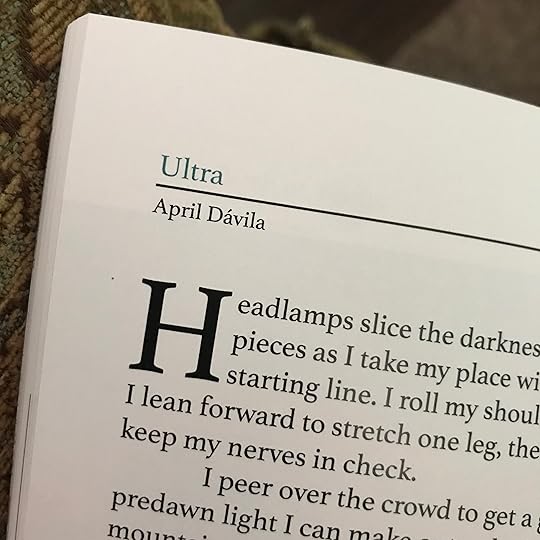
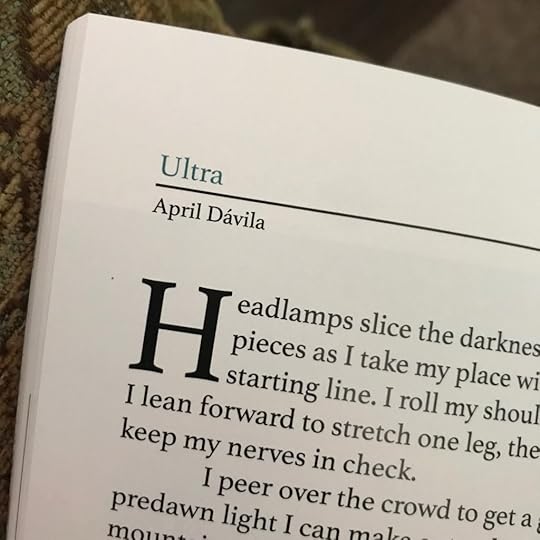
I found out last week that a short story of mine was nominated for a Pushcart Prize. It’s a flash fiction piece titled “Ultra.” I wrote it last year after meeting the editor of the Toho journal. They had a themed edition coming up and he invited me to submit something.
Well, I kind of have a policy of saying yes to anything career related, and I’d been kicking around an idea for my third novel, so I decided to go for it. I wrote a draft, then spent a couple of weeks working to get it under the flash fiction limit of 500 words and submitted it.
They liked it, published it, and I was thrilled. I’ve had a few short stories published before, but it’s never gone down like that. Then, out of the blue, I get an email from the editor saying they’ve selected my story as one of their five nominations for the Pushcart Prize.
I’ll be honest, my first response was actually “holy shit.” Because I don’t think of myself as a short story writer, and the Pushcart is kind of a big deal in the short story world.
So Excited
You can’t submit work for the Pushcart Prize. You can only have a piece nominated by an editor who has published your work in the preceding year.
Given that Toho Journal publishes flash fiction, they have literally put hundreds of short stories out into the world this year. The fact that they chose mine to be in their top five is such an honor.
I mean, the editor told me he loved the story, but I figured he was be cordial. What’s he going to say? Well, we needed to fill one more page and your story fit. Not likely.
Keeping It Real
Now, to put it in perspective, if every literary journal in the country gets to nominate 5 stories, that’s (by rough estimate) about 200,000 nominations.
Some (snobby-ass) authors argue that being nominated is nothing to brag about and that putting a Pushcart Prize nomination on your website or resume makes you look amateurish. Duly noted, douchebag. And I don’t give a shit.
Because you know what? As writers, we don’t get all that many opportunities to soak up praise. Just getting a story published is a pretty awesome feat in my book. Then to have it chosen by the editor for a little special attention is above and beyond. Definitely worth a line on my resume (and a blog post).
I don’t expect to win. Because I’ve read the Pushcart Prize publication and I know how high that bar is set. But, like Ms. Octavia says: It’s truly an honor to be nominated.



